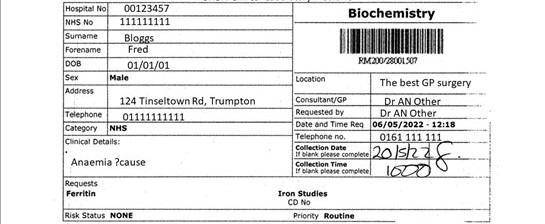By Jo Adaway, Consultant Clinical Scientist
June 2022
In the laboratory, we aim to report all results as soon as we possibly can, but sometimes issues with the request form or sample labelling can hold things up or lead to the request being rejected by the lab. Here are a few tips to try and ensure sample processing goes smoothly and your results are ready as quickly as they can be.
- Please make sure we have ALL of the following patient identifiers on the form:
- Forename
- Surname
- Date of birth
- Identification number e.g. NHS number, district number
- All samples MUST be labelled with:
- Hospital/district number or NHS number
- Surname
- Forename
- Date of birth
Without these, the request does not meet the specimen acceptance policy and the sample may be rejected. If the NHS number is not available eg. a foreign patient without an NHS number, please make this clear on the form.
- The address and telephone number of the patient are important if we need to communicate abnormal results to the out-of-hours service. It is very difficult for them to get in touch with the patient if we don’t have up-to-date contact details.
- Clinical details help us interpret test results and ensure we add the most appropriate comments. In some cases, they also help us decide if we need to add other tests to make sure you have the most appropriate biochemical information to help your patient.
- The location where the test was requested and the consultant are vital. Without these, we can’t send the results back to your system, and we can’t inform you of any critically abnormal results.
- The collection date and time is important, especially if the sample is not collected at the time of request. Some analytes are unstable, and if we don’t know when the sample was collected, there is a risk of inaccurate results being reported or the sample being rejected.
Example of a good request form, containing all the information needed
- It is also important the patient information is clear on the patient sample. If labels are used, please make sure these:
- Don’t extend beyond the tube. If they do, the sample might get stuck in our analysers, delaying your patient’s results and also many others
- Do contain four patient identifiers and that these match the details on the request form. Any mismatches or missing information that makes us doubt that the sample is from the correct patient will lead to the sample being rejected.
- Don’t have any barcodes on them eg. for the NHS number. We use barcodes to identify each sample, and if there is more than one barcode on a sample, our analysers cannot correctly identify it, and analysis is delayed.
Following these guidelines will help us to get your patient’s results reported quickly and avoid us having to reject samples.
 In this section
In this section
